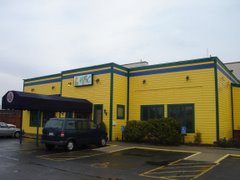This is good advice for those farmers who have been calling me asking about growing hops. I don't grow hops I use them, I don't know the first thing about growing a hop. So stop calling me and call a hop grower. I know that last years Global Hop Crisis sent hop prices skyrocketing and thus has enticed farmers into looking for a quick buck by planting a few acres of this beer ingredient. But perhaps these farmers don't have the first clue what they are getting into. Greg Kitsock wrote an article in the Dec. 2008 New Brewer titled Green Gold Rush: Shortages Spawn New Crop of Hop Farmers in which he outlined some of the challenges of growing hops. Kitsock writes,
"They've got gold dust in their eyes," says Ralph Olson the the would-be hop farmers who phone (once a day, on the average) to pump him for information on humulus lupulus. Some of them are profoundly ignorant about the plant. "They think hops grow on bushes, or in clusters like grapes."So, to all you would be hop farmers, go ahead and do what you will, but I would continue with what I know and let the hop farmers grow the hops.
Olsen is a 30 year veteran of the industry and general manager/owner of Hopunion a Yakima, Wash. based supplier for the craft brewing industry. "Not to be discouraging, but I don't give them a very good chance," he says of recent attempts to grow hops commercially outside the Pacific Northwest.
"If you want to grow a few vines for educational purposes or so you can make a wet hop beer, that's a good deal. Otherwise, it becomes difficult."
Some popular hops, like Simcoe, Amarillo and Palisade, are proprietary strains. The companies that own them invested millions into their development and aren't going to willingly share their rootstock. Hops, like wine grapes are sensitive to the terroir, they might not adjust well to the local soil and climate. Sierra Nevada's Manley notes that the brewery once grew Mount Hood, but "it didn't work out; they'd have beautiful cones and no acid."
Hops are also subject to the withering blast of a variety of pests, from fungal diseases like powdery and downy mildew to insect invaders like aphid and spider mites. The chemicals used to treat the vines are closely regulated state by state. Fungicides and insecticides available in Washington or Oregon might be banned elsewhere. Regarding organic growing method, Olson is cynical, "I've helped people start a few fields; they last three to four years, and then something comes in and nails them."
Large hop farms automate the harvest process to the greatest degree possible. They use a top-cutters and a bottom-cutters mounted on tractors to wrest the vines from the trellises. Next, the vines are fed into the hop-picker, a backyard-sized piece of machinery that knocks loose the cones while screening out the leaves and stems. A basic picker costs $750,000, reports Olsen.
The freshly picked hops are next heated in kilns to reduce the moisture content form 80% to under 10%. Building a kiln will add "another million or so" to your bill, notes Olson. That doesn't even get into the costs of baling and pelletizing them.
Hop prices, Olson concludes, can fluctuate greatly. This year, he estimates, 9,000 more acres were sown with hops. Add that to the 33,000 acres already producing hops and there could be a glut, not a shortage, in a few years. He foresees a downward trend in hop prices starting this year and lasting three to four years before prices stabilize.
Hop farming isn't for the faint of heart, Olson suggests. "when I stared in 1978, there were 225 grower. There are 50-60 growers today." Olson pegs the start up cost of a commercially viable hopyard as $4-10 million. He can't name a single successful hop farm outside Washington, Oregon and Idaho.
never trust The Sober Brewer
Jerry Gnagy

